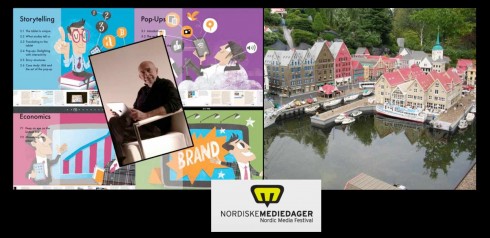TAKEAWAY: I continue to prepare for my presentation at the Nordic Media Festival conference in Bergen, Norway this week. What a difference a calendar year makes! As I take a look back at a similar presentation I did for the group in 2012, it’s like rewriting a book. TODAY: How social media impacts and benefits what we do as storytellers.


Social media was important, but not one of the centerpieces of my presentation to the Nordic Media Festival in 2012.
Today, no presentation can be completed without mentioning the vital importance of social media to both journalists and audience. If, as I often say, we in this business conducted journalism practices for years as if playing tennis against the wall (presenting information, but rarely engaging with the audience), today we play tennis against the likes of Serena Williams.
Both journalists and their audiences benefit when they interact via social media.
Social media keeps the conversations going, offering leads and threads about various topics that enhance what journalists present, give stories longer legs and, most importantly, create an organic relationship between sender and receiver.
Just to illustrate that the social media, too, are quite interested in what we do, now Twitter seeks a Head of News and Journalism. Based on the job description provided, it is a great job for someone who has “deep experience leading teams in reporting, editing or managing journalists, as well as a strong record of executing strategic partnerships.”
Perhaps the most telling part of the job description posted by Twitter is this:
You will be responsible for devising and executing the strategies that make Twitter indispensable to newsrooms and journalists, as well as an essential part of the operations and strategy of news organizations and TV news networks. You should have a strong vision for the broad potential of Twitter and news, while also being able to rigorously manage and scale the news team’s daily impact.
The word indispensable is key here. Not just Twitter, but all social media channels are indispensable to the practice of effective journalism today, and we have only scratched the service of how journalists and social media will interact in the future.
Twitter and Facebook, specifically, provide a fertile garden of ideas, a mirror to the trends that shape our lives, and an instant bulletin board of what people are talking about.
What people are talking about is key to providing content that connects with the audience. It is also the take off point for editors and reporters to expand, to enhance and to develop into further coverage.
Three centerpieces of notice
Now I prepare for the Friday presentation at Nordic Media Festival and the three centerpieces I have discussed here the past three days will be an integral part of my presentation as part of the essentials of storytelling today: smartphone editions, tablet development and social media engagement.
Will keep you posted and will report from Bergen Friday.
Previous blog posts about presentation for Nordic Media Festival
Preparing a presentation allows for some introspection
https://www.garciamedia.com/blog/articles/preparing_a_presentation_allows_for_some_introspection
Creating a new tablet edition? Newsy and pictorial may be the way to go
https://www.garciamedia.com/blog/articles/pcreating_a_new_tablet_edition_newsy_and_pictorial_may_be_the_way_to_go_p
Get ready for those smartphone editions
https://www.garciamedia.com/blog/articles/pget_ready_for_those_smartphone_editions_p
The Twitter job description here
https://twitter.com/jobs/positions?jvi=o5RpXfw2%2CJob
Highlight:
We are looking for a seasoned leader to shape and drive the next growth phase of Twitter’s partnership with the news industry. We believe Twitter is a valuable complement to the great work already being done and want to find ways for Twitter to help ensure the industry’s success.
For more information about the Nordic Days conference, May 8-10
Program and speakers
http://www.nordiskemediedager.no/om-mediedagene/nordic-media-festival/
Tomorrow in TheMarioBlog:
It’s presentation day at the Nordic Media Festival: here is an outline of my talk
Interview with Mario
A few months ago I had the honor of being interviewed for Contratapa, a media magazine published by the University of Navarra, Spain, and its School of Communications. Now the digital magazine is available.
In what is an unusual, but interesting, way of conducting an interview, the editor of the magazine asked 12 contemporary Spanish media designers and artists to submit questions for me.
Some were tough as in: Of all the projects you have completed, do you have any favorites?
My answer:
While I have no favorites, there are three that have impacted me for the scope of change and evolution—The Wall Street Journal, Die Zeit (Germany) and El Tiempo (Colombia)
The interview, in Spanish, is available here: